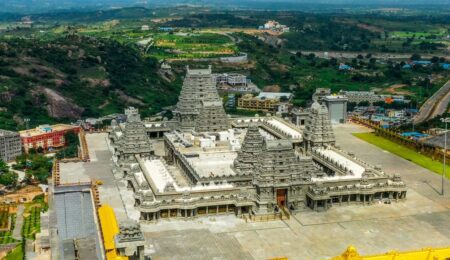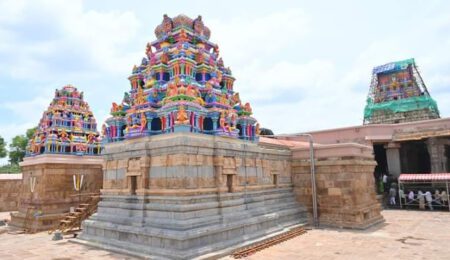The Sacred Story of Parli Vaijnath Temple: A Pilgrim’s Guide [2025]
Parli Vaijnath Temple stands as one of India’s 12 sacred Jyotirlingas, with a fascinating legend connecting it to the demon king Ravana, who reportedly brought the Lingam from the heavens. Standing 75 feet tall in Maharashtra’s Beed district, this ancient shrine draws thousands of devotees, especially during Mahashivratri.
The temple showcases a remarkable blend of Hemadpanthi and Indo-Aryan architectural styles, featuring intricate carvings and a brass-plated main entrance. In fact, its historical significance deepened when Rani Ahilyadevi Holkar renovated the structure in 1706, preserving its spiritual essence for future generations.
We’ve created this comprehensive guide to help you plan your pilgrimage to this sacred site. From the temple’s divine origins to practical details like visiting hours (5:00 AM to 9:30 PM daily) and accommodation options, we’ll cover everything you need to know for a meaningful spiritual journey.
The Divine Origin of Parli Vaijnath Jyotirlinga
Deep in Hindu mythology lies the extraordinary tale of how the Parli Vaijnath Jyotirlinga came to exist. Unlike other shrines, this sacred site carries profound significance through its divine origin and healing powers.
The Ravana and Lord Shiva Connection
The origin of Parli Vaijnath temple revolves around Ravana’s intense devotion to Lord Shiva. According to ancient texts, the demon king journeyed to Mount Kailasa and performed severe penance to please Lord Shankara. Despite enduring extreme cold, heat, and rain, when Shiva didn’t appear, Ravana began sacrificing his own heads one by one as offerings to the ShivaLinga.
After Ravana attempted to sacrifice his tenth head, Lord Shiva finally appeared, restored all his heads, and granted him boons. Ravana then requested to take Shiva to Lanka. The compassionate Shiva agreed but cautioned: “Carry my Linga with care and devotion, but never place it on the ground before reaching Lanka, or it will remain permanently wherever placed”.
On his journey home, Ravana needed to relieve himself. He asked a cowherd boy to hold the Linga temporarily. Unable to bear its immense weight, the boy eventually placed it on the ground. Consequently, as Shiva had foretold, the Linga remained fixed at that spot, becoming known as Vaidyanatheswar.
Why It’s Called Vaidyanath: The Healing Lord
The name “Vaidyanath” or “Vaijnath” translates to “Lord of Physicians”. This title emerged because Lord Shiva descended to cure the injured Ravana, thus acting as a divine doctor (called “Vaidya” in Hindu tradition).
The Parli Vaijnath Jyotirlinga possesses remarkable healing powers:
- Devotees are permitted to touch the Linga during worship, believed to facilitate healing and provide health benefits
- The Linga is said to contain both Amrit (elixir of immortality) and Dhanavantari (God of Medicine)
- The temple’s natural surroundings contribute to making it a destination for health and healing
Historical Evidence of Ancient Worship
Archeological and textual evidence suggests the Parli Vaijnath temple has been a center of worship for millennia. The site is associated with the legend of Savitri and Satyavan, who reportedly lived here. This connection implies Parali was once part of the Madra Kingdom, ruled by King Ashvapati, Savitri’s father.
Furthermore, young Sage Markandeya is believed to have received immortality from Lord Vaidhyanath at this very spot. Since Markandeya lived contemporaneously with Mahabharata events and interacted with King Yudhishtira, scholars suggest the Shivalinga dates back at least to that era, if not earlier.
Although the original structure suffered damage during Aurangzeb’s conquests, Rani Ahilyadevi Holkar renovated the temple in 1706 AD, preserving its spiritual legacy for future generations.
Temple Architecture and Sacred Spaces
Perched majestically atop a hill, the Parli Vaijnath Temple’s architecture embodies both spiritual significance and artistic brilliance. Standing approximately 75-80 feet above ground level, this stone sanctuary draws pilgrims seeking divine connection and architectural enthusiasts alike.
The Hemadpanthi Style of the Main Structure
The temple exemplifies the distinctive Hemadpanthi architectural style, characterized by its robust stone construction and intricate detailing. Four strong walls surround the structure, creating a protective embrace around the sacred space within. The main entrance, situated on the eastern side, features magnificent brass-plated doors that gleam in the morning sunlight.
Accessibility to this elevated shrine comes via a wide staircase that not only serves a practical purpose but adds to the temple’s regal presence. As I climbed these steps, I noticed how they create a natural transition from the mundane world to the sacred realm above.
In 1706, the devout Shiva worshiper Ahalyadevi Holkar renovated the temple[38], preserving its spiritual essence while reinforcing its structural integrity. Near the main gate (Mahadwar), visitors can observe a distinctive minaret known locally as “Prachi” or “Gawaksha” (window), adding architectural intrigue to the complex.
Inside the Sanctum: The Jyotirlinga
The heart of the temple holds its most precious treasure—the sacred Jyotirlinga. Unlike at many other sacred sites, devotees here can actually touch the Jyotirlinga while offering prayers, creating an intimate spiritual experience.
The Jyotirlinga itself is smooth and crafted from black Shaligram stone. This tactile connection with the divine is believed to channel healing energies directly to worshippers, reinforcing the temple’s association with medicinal powers. Additionally, the spacious corridors and courtyard accommodate the flow of devotees, particularly during auspicious occasions.
Other Deities and Shrines in the Complex
The spiritual landscape surrounding Parli Vaijnath Temple includes several notable shrines. Directly across from the main temple stands the unique Bal Ganesh temple, featuring a self-formed Ganesh idol without a trunk—reportedly the only such representation in India.
Nearby temples include the Kedareshwer Temple, Kalratri Devi Mandir, and Shree Bajarangbali Vetal Mandir. Moreover, the Hanuman Gad offers another sacred space for devotees seeking divine blessings in the vicinity.
The entire complex creates a spiritual ecosystem centered around the Jyotirlinga, with each shrine contributing to the rich tapestry of worship opportunities for pilgrims visiting this sacred destination.
Essential Rituals and Offerings at Parli Temple
At the heart of worship at Parli Vaijnath Temple lies a series of sacred rituals that connect devotees directly to Lord Shiva’s divine energy. These time-honored practices attract thousands of pilgrims daily who seek blessings through personal participation in these powerful ceremonies.
Rudrabhishek: The Sacred Bathing Ceremony
The Rudrabhishek at Parli Vaijnath is a profound ritual where the Shiva Lingam receives a sacred bath while priests chant powerful Vedic mantras. This ceremony involves offering Panchamrut (milk, curd, honey, ghee, and Ganga jal) to the Shivling.
Notably, unlike most temples, devotees themselves perform the abhisheka here, using bilwa leaves purchased outside the temple premises. During this ritual, male devotees must follow the specific tradition of not wearing clothes above the waist.
The Rudrabhishek timing runs from 5:00 AM to 7:00 AM daily, with the complete ceremony taking approximately 2.5 to 3 hours. Performing this ritual is believed to bring peace, harmony, spiritual growth, and remove negative energies.
Daily Aarti Schedule and Significance
The temple follows a structured daily worship schedule:
- Kakad Aarti (Morning): 5:00 AM – 5:30 AM
- Madhyan Aarti (Midday): 12:00 PM – 12:30 PM
- Sandhya Aarti (Evening): 6:30 PM – 7:00 PM
- Shej Aarti (Night): 9:00 PM – 9:30 PM
Each aarti creates a spiritually uplifting ambiance through traditional music and the recitation of “Om Namah Shivaya”. These ceremonies purify the mind and body while removing fear from devotees’ lives.
Special Monday Rituals
Mondays hold special significance for Shiva worship, with extended hours for rituals. On these days, the puja timing extends from 5:00 AM to 8:00 AM and 12:00 PM to 7:00 PM, compared to the standard hours on other days.
The Somvar Pooja (Monday worship) includes special ceremonies such as Shadopachar at 5:00 AM and Shringar Pooja at 6:00 PM. Additionally, devotees believe performing Rudrabhishek on Mondays brings particularly powerful blessings.
What to Offer: Prasad and Donations
For those visiting Parli Vaijnath Jyotirlinga, traditional offerings include:
- Bilwa leaves (considered especially sacred to Lord Shiva)
- Flowers and fruits
- Milk for abhishekam
A unique aspect of this temple is the cross-offering tradition during festivals, where priests present bilwa leaves (usually Shiva’s offering) to Vishnu and basil leaves (typically Vishnu’s offering) to Shiva.
For those seeking organized ritual services, the temple offers options like Laghu Rudrabhishek (₹6,499 including puja materials and priest dakshina) and various other specialized pujas to address specific life challenges.
Practical Information for Pilgrims
Planning your pilgrimage to Parli Vaijnath Temple requires attention to practical details that will enhance your spiritual experience. Here’s everything you need to know for a smooth visit to this sacred Jyotirlinga.
Parli Vaijnath Temple Timings Throughout the Year
The temple operates daily from 5:00 AM to 9:30 PM. For specific rituals, timings are:
- Rudrabhishek: 5:00 AM to 2:00 PM
- Abhishek: 5:00 AM to 7:00 AM
- Afternoon Pooja: 1:00 PM to 1:30 PM
- Bhasma Pooja: 3:00 PM to 5:00 PM
On Mondays (Somvar), Pradosh, and Shivaratri, abhishek timings extend from 5:00 AM to 8:00 PM, allowing more devotees to participate.
Best Time to Visit for Darshan
Winter months (October to February) offer the ideal climate for visiting Parli Vaijnath Temple. Early mornings provide the most peaceful darshan experience, typically between 5:00-7:00 AM. Nevertheless, devotees mention that even on regular days, the temple rarely experiences overwhelming crowds.
Accommodation: Hotels Near Parli Vaijnath Temple
Several accommodation options exist within 1-2 km of the temple:
- Triveni Bhawan (Guesthouse)
- Hotel Halge Garden
- Hotel Arya Executive
- Parli Vaijnath Bhakta Niwas
- Shri Vaijnath Devasthan Trust Bhakta Niwas
Additionally, MTDC cottages provide state-run accommodations. Many pilgrims recommend staying in Ambajogai for better standards.
Transportation: How to Reach the Temple
Parli Vaijnath is accessible via:
- By Air: Nearest airport is in Nanded (105 km)
- By Train: Parli Railway Station is just 2 km from the temple[69]
- By Road: Well-connected by busses from Aurangabad, Mumbai, Pune, and Nagpur
Aurangabad, with excellent air and rail connectivity, serves as a convenient gateway to Parli Vaijnath.
Dress Code and Temple Etiquette
For abhishek rituals, men must enter the sanctum bare-chested (no shirts/banians)[72]. Respectful traditional attire is recommended for all visitors. Cameras and mobile phones are permitted inside, though photography inside the temple is prohibited.
Conclusion
Parli Vaijnath Temple stands as a testament to both divine power and architectural brilliance. Through my research and visits, I’ve witnessed how this sacred Jyotirlinga combines spiritual healing with historical significance, making it truly unique among India’s holy sites.
The temple’s distinctive features set it apart from other religious destinations. Unlike most shrines, devotees can touch the Jyotirlinga directly, creating a personal connection with the divine. Additionally, the temple’s healing powers, attributed to Lord Shiva’s role as Vaidyanath, draw countless pilgrims seeking physical and spiritual wellness.
Ancient legends, architectural grandeur, and sacred rituals blend seamlessly at this holy site. Whether participating in the early morning Rudrabhishek or attending the evening aarti, pilgrims experience profound spiritual moments within these hallowed walls. The temple’s convenient location and well-organized facilities ensure a meaningful pilgrimage for all who visit.
This sacred shrine certainly deserves its place among India’s most revered Jyotirlingas. While planning your visit, remember that winter months offer the most pleasant weather, and early morning hours provide the most peaceful darshan experience.

![The Sacred Story of Parli Vaijnath Temple: A Pilgrim's Guide [2025] 1 parli vaijnath temple](https://kirtankar.com/wp-content/uploads/2025/03/Parli-Vaijnath-Temple-1080x650.jpg)


Leave a Comment